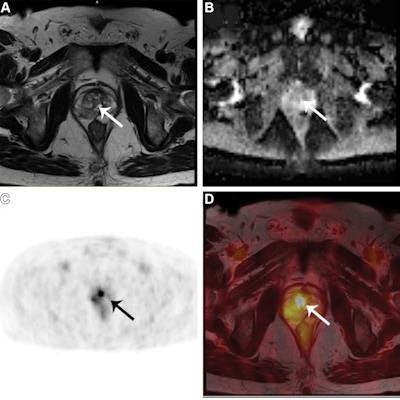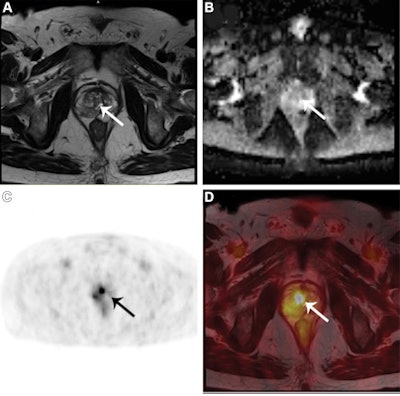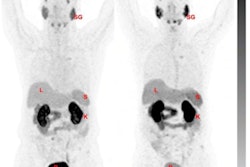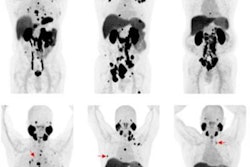
Functional imaging with PET/MRI is better than anatomic imaging alone for detecting prostate cancer in men who have a significantly higher chance of developing the disease, according to research published August 31 in Radiology.
Israeli researchers conducted a head-to-head comparison of sensitivity, specificity, and accuracy prior to biopsy between multiparametric MRI and PET/MRI with a radiotracer based on gallium-68 (Ga-68) prostate-specific membrane antigen (PSMA). They found the specificity of Ga-68 PSMA PET/MRI was higher for detecting cancer in men with elevated prostate-specific antigen (PSA) levels.
The findings underscore the superiority of PET/MRI and could impact prostate cancer diagnosis, potentially leading to more effective treatment options.
"Gallium-68 prostate-specific membrane antigen PET/MRI improved specificity for clinically significant prostate cancer compared with multiparametric MRI," wrote first author Dr. David Margel, PhD, and colleagues at Tel Aviv University.
Currently, the European Association of Urology and the American Urological Association recommend prostate imaging with multiparametric MRI before biopsy for men with elevated PSA levels. Despite this, the diagnostic performance of multiparametric MRI is far from perfect in the initial diagnosis of prostate cancer, according to the authors.
Ga-68 PSMA is a PET tracer approved by the U.S. Food and Drug Administration (FDA) in December 2020 for prostate cancer patients with suspected metastases, as well as in patients with suspected recurrence based on elevated PSA levels.
Several studies have compared functional and anatomic imaging, but the authors noted that very little data is available on how they compare before targeted biopsies are performed. They added that detecting prostate cancer with a highly accurate imaging approach may reduce unnecessary, costly biopsies.
In this prospective study, the investigators compared the diagnostic accuracy of multiparametric MRI and Ga-68 PSMA PET/MRI between June 2019 and March 2020 in 99 men with elevated PSA levels. The men ranged in age between 62 and 71 years old. Men with PSA levels of 2.5 to 20 ng/mL were included.
Multiparametric MRI scores of at least 3 on the Prostate Imaging and Data System (PI-RADS) system were considered abnormal findings, while Ga-68 PSMA PET scans that showed maximum standardized uptake values (SUVmax) of at least 2.5 g/mL were considered positive findings.
The researchers found that specificity was 76% for Ga-68 PSMA PET/MRI compared with 49% for multiparametric MRI for detecting clinically significant prostate cancer. Sensitivity was similar between the two approaches. For PI-RADS 3 lesions, specificity was also higher for Ga-68 PSMA PET/MRI than for multiparametric MRI at 86% versus 59%.
 (A) Axial T2-weighted (B) axial apparent diffusion coefficient map, (C) Ga-68 PSMA PET, and (D) fused T2-weighted and Ga-68 PSMA PET/MRI scans in a 64-year-old man with a PI-RADS grade 3 lesion (arrows in A-D) in the right transition zone at multiparametric MRI. Maximum standardized uptake value (SUVmax) in A-D was 4.4. Targeted fusion biopsy diagnosed an International Society of Urological Pathology grade 2 prostate cancer. Image courtesy of Radiology.
(A) Axial T2-weighted (B) axial apparent diffusion coefficient map, (C) Ga-68 PSMA PET, and (D) fused T2-weighted and Ga-68 PSMA PET/MRI scans in a 64-year-old man with a PI-RADS grade 3 lesion (arrows in A-D) in the right transition zone at multiparametric MRI. Maximum standardized uptake value (SUVmax) in A-D was 4.4. Targeted fusion biopsy diagnosed an International Society of Urological Pathology grade 2 prostate cancer. Image courtesy of Radiology.
| Multiparametric MRI vs. Ga-68 PSMA PET/MRI for detecting prostate cancer | ||
| MRI | Ga-68 PSMA PET/MRI | |
| Sensitivity | 92% | 88% |
| Specificity | 49% | 76% |
| Positive predictive value | 46% | 63% |
| Negative predictive value | 93% | 93% |
| Accuracy | 63% | 80% |
In addition, for patients with PI-RADS 3 lesions, PET/MRI could reduce the number of biopsies compared with MRI by 55% versus 36%, the researchers stated. The net benefit of targeted biopsy was similar between the two approaches for PI-RADS 4 and 5 lesions, however, regardless of PSMA uptake.
"In this prospective trial, we found that the specificity of gallium-68 (Ga-68) prostate-specific membrane antigen (PSMA) PET/MRI was higher than that of multiparametric MRI," the researchers wrote.
Since MRI before biopsy has become the standard of care, the study warrants further investigations on how functional and anatomic imaging may provide complementary
and added efficacy for accurate assessment of the extent of prostate cancer, the researchers suggested.
"Larger confirmatory studies will be needed," they concluded.





















